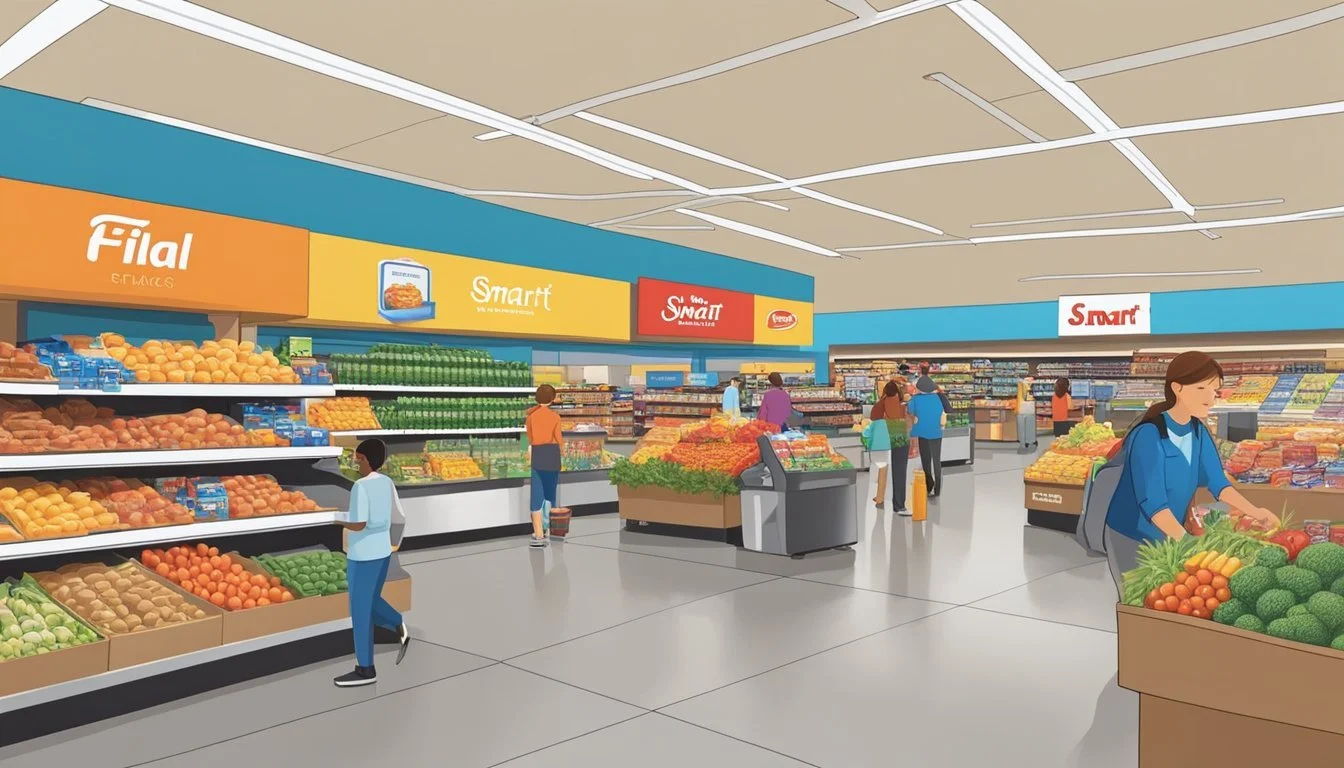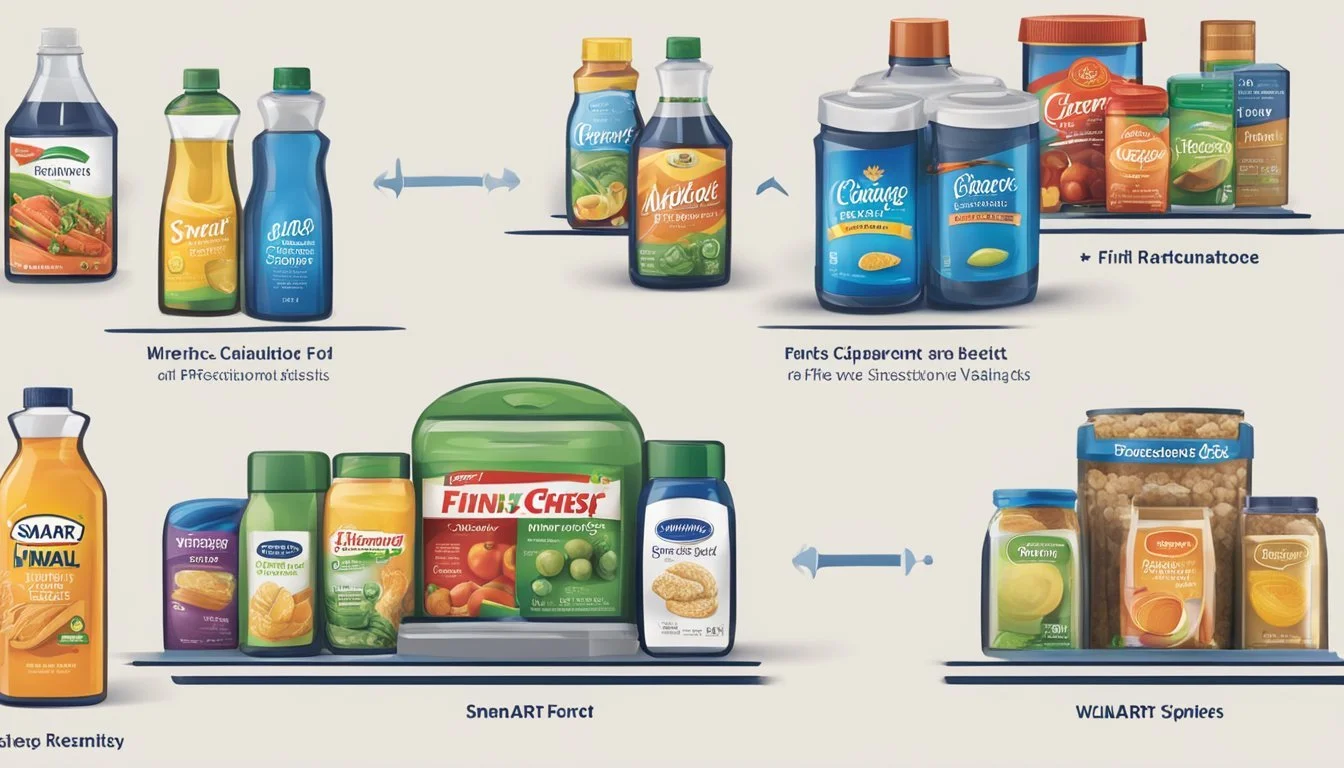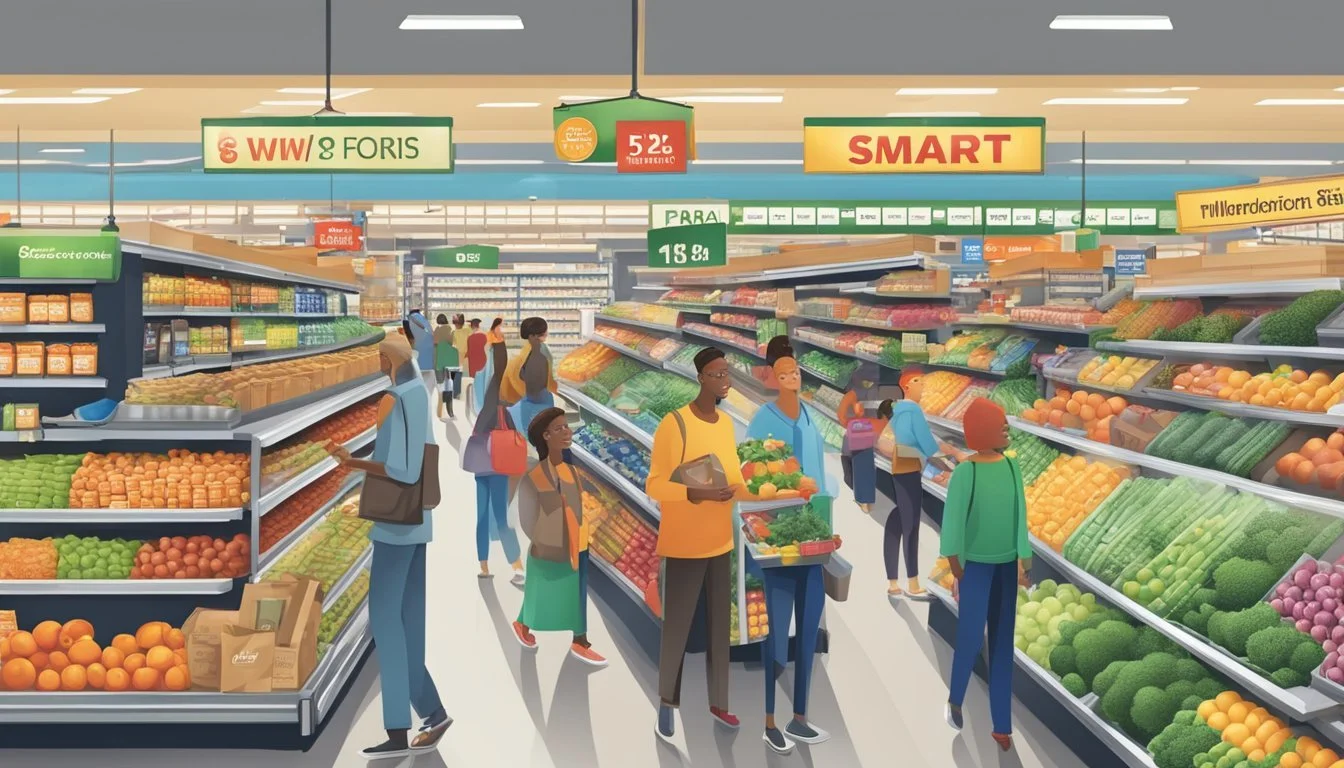Smart & Final vs Walmart
A Comprehensive Comparison of Prices, Selection, and Convenience
Smart & Final and Walmart are two prominent grocery chains that cater to budget-conscious shoppers. Both stores offer a wide range of products at competitive prices, aiming to provide value for families and individuals alike.
Smart & Final tends to have slightly lower prices overall compared to Walmart, with groceries averaging 14% less than typical supermarkets. This price difference can result in significant savings for families who spend hundreds of dollars per month on groceries. Smart & Final positions itself as a warehouse-style store without membership fees, while Walmart leverages its massive scale to keep prices low.
Product selection varies between the two retailers. Walmart typically offers a broader range of non-grocery items alongside its food products. Smart & Final focuses more on bulk purchases and restaurant-quality goods, which may appeal to certain shoppers. Ultimately, the choice between Smart & Final and Walmart often comes down to individual preferences, store locations, and specific product needs.
Company Overviews
Smart & Final and Walmart are major players in the grocery retail industry. Each company has a unique history, store presence, and business approach that shapes their offerings and customer experience.
History and Branding
Smart & Final traces its roots back to 1871 when it was founded in Los Angeles. The company's name comes from its founders, J.S. Smart and H.D. Final. Smart & Final has positioned itself as a hybrid retailer, combining elements of a warehouse store with a traditional grocery market.
Walmart, founded in 1962 by Sam Walton, started as a discount store in Rogers, Arkansas. The company's growth has been phenomenal, becoming the world's largest retailer. Walmart's brand is synonymous with everyday low prices and a wide range of products.
Store Locations and Accessibility
Smart & Final operates over 250 stores, primarily concentrated in the western United States. The company has a strong presence in California, with additional locations in Nevada, Arizona, and northern Mexico.
Walmart boasts a massive network of over 10,500 stores worldwide, with about 4,700 locations in the United States alone. Walmart stores can be found in all 50 states, making them highly accessible to most Americans.
Business Models and Store Types
Smart & Final focuses on a unique hybrid model. Their stores cater to both household consumers and small businesses. The company offers bulk items alongside individual products, providing a mix of warehouse club and traditional grocery store experiences.
Walmart operates several store formats:
Walmart Supercenter: Large stores offering groceries and general merchandise
Walmart Neighborhood Market: Smaller grocery-focused stores
Sam's Club: Membership-based warehouse stores
Walmart's diverse store types allow them to serve various customer needs and compete with traditional supermarkets, warehouse clubs, and specialty retailers.
Product Range and Quality
Smart & Final and Walmart both offer extensive grocery selections, but they differ in their product ranges and quality. Each store caters to different customer needs with varying focuses on fresh produce, organic options, and specialty items.
Variety of Products Offered
Smart & Final provides a mix of household and business-oriented products. They stock bulk items, restaurant-quality goods, and everyday groceries. Their selection includes a wide range of meats, produce, dairy, and pantry staples.
Walmart, on the other hand, offers a broader assortment of general merchandise alongside groceries. Their supercenters carry everything from electronics to clothing, in addition to a full range of food products. Walmart's grocery section typically includes national brands and their own Great Value line.
Both stores carry frozen foods, baked goods, and household essentials. Walmart tends to have more variety in non-food items, while Smart & Final excels in bulk quantities and food service products.
Quality of Fresh Produce
Fresh produce quality can vary between the two retailers. Smart & Final often sources produce locally when possible, which can result in fresher items. They typically offer a good selection of fruits and vegetables, including some less common varieties.
Walmart's produce section is generally larger, with a wide range of options. However, the quality can be inconsistent across different store locations. Some Walmart stores have improved their produce handling and storage practices in recent years.
Both chains strive to maintain competitive prices on their fresh produce. Smart & Final may have an edge in produce intended for commercial use, while Walmart often has lower prices on common fruits and vegetables.
Organic and Specialty Products
Smart & Final has expanded its organic offerings in recent years. They carry organic produce, meats, dairy products, and packaged goods. Their Sun Harvest brand provides affordable organic options. Specialty items at Smart & Final often cater to food service needs and ethnic cuisines.
Walmart has significantly increased its organic selection, particularly through its Great Value Organic line. They offer organic versions of many staple items like eggs, milk, and produce. Walmart's specialty products tend to focus more on trendy food items and dietary restrictions like gluten-free options.
Both stores stock specialty products, but Smart & Final may have a wider range of commercial-grade and ethnic foods. Walmart typically offers more variety in specialty diet products and trendy health foods.
Pricing and Savings
Smart & Final and Walmart both aim to offer competitive prices, but their approaches to savings differ. Each store has unique strategies for providing value to customers through pricing, promotions, and loyalty programs.
Overall Price Comparison
Walmart generally offers lower prices on everyday items compared to Smart & Final. A typical grocery basket at Walmart tends to be 10-15% cheaper than at Smart & Final. However, Smart & Final often has better deals on bulk purchases and restaurant-quality items.
Walmart's "Everyday Low Price" strategy keeps costs consistently low across most products. Smart & Final, on the other hand, focuses on competitive pricing for larger quantities and commercial-grade goods.
For staple items like milk, eggs, and bread, Walmart usually wins on price. But Smart & Final can be more economical for families or businesses buying in bulk.
Discounts, Sales, and Promotions
Both stores run regular sales and promotions, but their focus differs. Walmart frequently offers rollbacks on popular items, reducing prices for extended periods. They also use loss leaders - selling certain products below cost to attract customers.
Smart & Final's promotions often target bulk buyers and small businesses. They run weekly specials on larger quantities and commercial products. Their "Buy More, Save More" deals can provide significant savings for high-volume purchases.
Walmart's app features digital coupons and personalized offers. Smart & Final distributes weekly flyers with store-specific deals. Both stores match competitors' prices on identical items.
Membership and Loyalty Programs
Walmart+ is Walmart's premium membership program. For $98 annually, members get free shipping, fuel discounts, and early access to deals. The Walmart credit card offers cashback on purchases.
Smart & Final doesn't have a paid membership program. Instead, they offer a free loyalty program called Smart Rewards. Members earn points on purchases, which can be redeemed for discounts on future shopping trips.
Walmart's program focuses on convenience and exclusive perks. Smart & Final's rewards system emphasizes earning points for savings. Neither store requires membership for shopping or accessing sale prices.
Shopping Experience
Smart & Final and Walmart offer distinct shopping experiences for grocery shoppers. Each store has its own approach to customer service, store layout, and checkout processes.
Customer Service and Staff
Smart & Final typically employs fewer staff members per store compared to Walmart. This can result in less assistance available on the sales floor. Walmart often has more employees present, potentially leading to quicker response times for customer inquiries. However, the quality of customer service can vary between individual stores and staff members at both chains.
Smart & Final staff tend to be knowledgeable about bulk purchases and restaurant supplies. Walmart associates generally have broader product knowledge across various departments.
Store Layout and Navigation
Smart & Final stores are usually smaller and more compact than Walmart Supercenters. This can make navigation easier for shoppers familiar with the layout. Products are often organized in a warehouse-style format, with bulk items prominently displayed.
Walmart Supercenters are larger, offering a wider variety of non-grocery items. The expansive layout can be overwhelming for some shoppers, but clear signage helps with navigation. Grocery sections are typically well-organized, with similar items grouped together.
Both stores use aisle markers and category signage to assist customers in finding products.
Checkout Efficiency
Smart & Final often has fewer checkout lanes than Walmart, but lines may move quickly due to the focus on bulk purchases and fewer small items. Self-checkout options are available at many locations.
Walmart typically offers more checkout lanes, including dedicated express lanes for customers with fewer items. Self-checkout kiosks are common, helping to reduce wait times during busy periods.
Both stores use barcode scanning technology for efficient item processing. Walmart has been implementing "Scan & Go" technology in some stores, allowing customers to scan items with their smartphones for a quicker checkout experience.
Grocery Shopping Options
Smart & Final and Walmart offer diverse grocery shopping experiences to meet customer needs. Both stores provide in-store and online options, as well as delivery and pickup services.
In-Store Versus Online Shopping
In-store shopping at Smart & Final and Walmart allows customers to personally select items and compare prices. Shoppers can inspect produce, check expiration dates, and discover new products. Online shopping provides convenience and time-saving benefits. Walmart's website offers a user-friendly interface with detailed product information and customer reviews. Smart & Final's online platform allows for easy reordering of frequently purchased items.
Both retailers' websites feature search functions, digital coupons, and the ability to create shopping lists. Online shopping also enables price comparisons between stores and access to a wider range of products that may not be available in physical locations.
Grocery Delivery and Pickup Services
Smart & Final and Walmart have adapted to changing consumer preferences by offering delivery and pickup options. Walmart partners with services like Instacart for same-day grocery delivery. The retailer also provides its own pickup service, allowing customers to order online and collect groceries from designated store locations.
Smart & Final offers delivery through third-party services in select areas. Their pickup option lets shoppers place orders online and retrieve them from nearby stores. Amazon Prime members can access grocery delivery from Whole Foods Market, providing another competitive option in the market.
These services cater to busy schedules and those who prefer to avoid in-store shopping. Delivery fees and minimum order requirements vary, so customers should compare options to find the most cost-effective solution for their needs.
Market Position and Consumer Preferences
Smart & Final and Walmart occupy distinct positions in the grocery market, appealing to different consumer segments. Their strategies and offerings cater to varying shopper preferences and needs.
Loyal Customer Base
Smart & Final attracts a dedicated following among small business owners, large families, and budget-conscious shoppers. Its bulk offerings and competitive pricing on restaurant-quality items appeal to these groups. Walmart, on the other hand, draws a broader customer base with its extensive product range and everyday low prices.
Families often choose Walmart for its one-stop shopping experience, combining groceries with household items and clothing. Smart & Final's loyal customers appreciate its no-frills approach and focus on food and supplies.
Market Research and Consumer Choices
Researchers have found that area consumers often split their grocery shopping between multiple stores. Walmart's market dominance stems from its ability to meet diverse needs under one roof. Smart & Final carves out its niche by catering to specific consumer preferences for bulk purchases and commercial-grade products.
Consumer choices are influenced by factors like price, quality, and convenience. Walmart's extensive market research allows it to tailor offerings to local preferences. Smart & Final focuses on understanding the needs of its core customer segments, refining its product mix accordingly.




